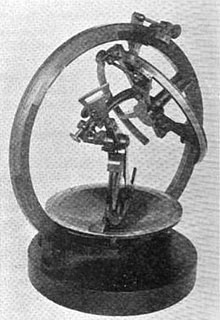
An equatorial sextant is a modified version of a sextant. One historically significant instrument called by that name was John Flamsteed's equatorial sextant, installed in the Greenwich Observatory in 1676. Seven feet across and possessing an iron frame, it was mounted at an angle that aligned with the celestial equator, so that as it rotated, it tracked the motion of objects across the night sky. Flamsteed used this instrument to measure angles of right ascension from 1676 through 1689 or 1690.
Another device known by that name was patented by the American inventor William Austin Burt in 1856. Burt's equatorial sextant included several elaborations on the basic sextant design, which enabled its user to determine navigational information without a supplemental chart or the need for calculation.
References
- Laurie, P. S. (1960). "The buildings and old instruments of the Royal Observatory, Greenwich". The Observatory. 80: 12–22. Bibcode:1960Obs....80...13L.
- Chapman, Allan (September 1984). "Tycho Brahe in China: the Jesuit mission to Peking and the iconography of European instrument-making processes". Annals of Science. 41 (5): 417–443. doi:10.1080/00033798400200341. ISSN 0003-3790.
- "Telescope: Flamsteed's 7-foot Equatorial Sextant (1676)". www.royalobservatorygreenwich.org. Retrieved 2023-03-01.
- Chapman, Allan (September 1995). "Out of the meridian: John Bird's equatorial sector and the new technology of astronomical measurement". Annals of Science. 52 (5): 431–463. doi:10.1080/00033799500200341. ISSN 0003-3790.
- "Equatorial Sextant". National Museum of American History. Retrieved 2023-02-28.
- Briley-Webb, Linda (2019-02-22). "Equatorial sextant". In Welch, Rosanne; Lamphier, Peg A. (eds.). Technical Innovation in American History: An Encyclopedia of Science and Technology [3 volumes]. ABC-CLIO. pp. 225–226. ISBN 978-1-61069-094-2.